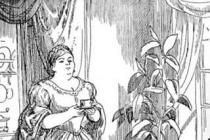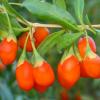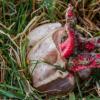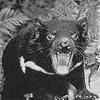June 6th, 2016
Nature is simply amazing. The variety of forms of flora and fauna is truly impressive. Today we will pay close attention to the kingdom of Mushrooms. The specimens mentioned below have such an unusual appearance that, at first glance, it is impossible to figure out that they are mushrooms. You will be shocked!
Vaulted star (lat. )
It seems as if Mother Earth decided to create a mushroom in the image and likeness of man. The vaulted asterisk really resembles a human figure. Also, this mushroom looks like a domed earth star. Therefore, among the people, in English-speaking countries, they call it that. The second version of the name is an acrobatic earth star.
It reaches a height of 4-8 cm. It is usually found singly or in small groups in the forests of North America and Europe, mainly in Mexico and the southwestern United States of America. If you find this mushroom, you should know that it is inedible.
Trembling brain (lat. ) - forest brain
In a cut.
Striped goblet (lat. ) - a small bird's nest with miniature eggs
What tiny bird found this nest and laid her eggs in it? Calm down: this is not at all the work of the wings of a miniature bird. We are talking about a beautiful striped cup mushroom, or, as it is also called, striped cyatus. You can find these summer and autumn on dead wood in temperate regions all over the planet: in Asia, in Europe, in North, Central and South America, in New Zealand. The color and size of the striped goblets may vary slightly, but, as a rule, they are no more than 1 cm in width and height. Cyatus striped has a gray or brown color. By the way, in the scientific literature, tiny "eggs" are called peridioles.
Auricularia ear-shaped (lat. ) - the forest hears everything
Ears in the middle of the forest? It looks like a David Lynch movie. But it can actually happen to you. You can even eat them if you like. In fact, these are mushrooms called auricularia auricularis. Their size varies from 3 to 12 cm. You can meet these reddish-brown "ears" in wet places, mainly on dead deciduous trees and shrubs. Mushrooms grow all year round, but they are most often found in autumn. They are widely distributed in temperate and subtropical climates throughout the world.
Mushroom auricularia auricularis in Asia, especially China, is considered delicacy. It is specially grown on dead wood, for example, wood of cork oak, elderberry, banana of paradise. While in the People's Republic of China, you can try the Chinese Black Mushroom Soup, an essential ingredient of which the aforementioned mushroom is. Auricularia auricularis is also used for making salads. In China, Ghana, Nigeria, it is believed that dishes from these mushrooms are medicinal. In particular, the Chinese believe that soup with "ears" helps in the fight against colds and fevers.
Anthurus archer (lat. Clathrus archeri) - devil's fingers, octopus or starfish?
When the Archer Anthurus mushroom opens, outwardly it resembles a starfish or an octopus. Usually has 4 to 7 pinkish-red "tentacles". Popularly known as the fingers of the devil, the scariest mushroom in the world. It is easy to recognize it not only by its appearance, but also by the terrible unpleasant smell of carrion. The scent attracts flies, which spread the spores. Anthurus archer grows in groups, often among wood chips, old stumps and stale foliage. It originally grew in Australia and Tasmania, but now it can be found in Europe, North America, and Asia. Do not try this mushroom open, it is inedible.
Undisclosed.
Gidnellum pitcha (lat. ) - "bleeding" mushroom
If you walk through the forests of North America and some European countries, you may find a mushroom with a frightening folk name, bloody tooth or devil tooth. Although there are people who look at it from a culinary point of view. To them, the mushroom resembles ice cream with strawberry syrup.
Only young wet mushrooms can “bleed” with a bright red liquid. Interestingly, the liquid contains an effective anticoagulant. While young, the hindellum pitcha is easy to identify, but as it ages, the fungus becomes brown and inconspicuous. "Bleeding" mushroom inedible although it is not toxic. It is extremely bitter in taste. The size of the fungus ranges from 5 to 10 cm in height. Gindellum peka grows on the ground under coniferous trees, often among mosses. Mutually beneficial relationships are established between the roots of some trees and these fungi, and useful substances are exchanged.
- dead man's fingers
When this mushroom is encountered on the way, it seems that the dead man tried to get out of his grave with his own hands. But again we are talking about mushrooms, the popular name of which dead man's fingers. Inedible mushrooms Xylaria polymorpha appear in spring, most often on damaged stumps or rotten wood. At first they are bluish or bluish, then, by the summer, the mushrooms gradually acquire an ominous look for the human eye. Polymorpha means "many forms". As the name suggests, the form of Xylaria polymorpha fungi is very diverse. But in most cases, the shape is club-shaped, that is, thickened at one end.
young mushrooms.
mature black mushrooms.
in a cut.
Horror! Spilled zombie fingers.
How do you like a selection of unusual mushrooms? Which one surprised you the most? Share your opinion on social networks!
Nature is the most unpredictable creator. She can create not only amazing plants, but also those that, frankly, terrify a person. One of her creations is a demonic mushroom, "devil's fingers", as it is popularly called. What does it look like, where is it found and can it be eaten? More on this later.
Anthurus Archer is a fungus of the Lattice genus (Veselkov family) capable of changing its appearance. Its initial state is the shape of an egg with a diameter of about 5 cm. 
During this period, it is easy to confuse it with a whitish grebe or some kind of alien creature. "Devil's fingers" have a multi-layered structure:
- mucous jelly-like membrane;
- core (receptacle and spore layer).
Important! Anthurus Archer is listed in the Red Book.
During the flowering period (from August to October inclusive), the egg shell bursts and releases no more than 8 petals, the tops of which have grown together. Their length is up to 10 cm. Soon the petals separate and become like octopus tentacles or helicopter blades.
Inside, they resemble a porous sponge. The petals are rather brittle, covered with dark spots and spores, emitting a disgusting smell.
The final form is a star (or flower) with a diameter of 15 cm. It does not have a clear leg. The smell that the "devil's fingers" spread during flowering attracts flies, so that they, in turn, spread the spores of the plant.  This is a fairly effective method of distribution, which is usually not characteristic of fungi.
This is a fairly effective method of distribution, which is usually not characteristic of fungi.
After the petals have completely emerged from the bursting egg shell, Anthurus Archer lives only a few days. This is quite enough to prolong the genus.
Did you know? Mushrooms produce vitamin D if they get enough sunlight. This is reflected in the color of their hats.
The devil's fingers mushroom comes from Australia (Tasmania) and New Zealand. A little later, he became known to Africans, Asians, Americans and residents of the islands of St. Helena and Mauritius. Europeans still treat him like an alien. There is no exact data on the appearance of "devil's fingers" in Europe.
There is an opinion that for the first time the mushroom was brought in 1914-1920 to French territory from Australia in wool, which was supplied for the textile industry.
He had a good acclimatization and settled down here. A little later, information began to appear about the stay of the “fingers of the devil” in German (1937), Swiss (1942), English (1945), Austrian (1948) and even Czech (1963) territories.  It appeared in the countries of the USSR in 1953, in particular in 1977 in Ukraine and 1978 in Russia.
It appeared in the countries of the USSR in 1953, in particular in 1977 in Ukraine and 1978 in Russia.
Important! The devil's fingers mushroom is recognized as the most creepy in the world precisely because of its appearance during the flowering period.
Its habitual habitat is mixed and deciduous forests with humus soil and decaying wood, desert or semi-desert. These mushrooms can grow in groups if climatic conditions allow it.
Anthurus Archer or "devil's fingers", despite its terrifying appearance, can be eaten. Those who still dare to try it say that the taste is as unpleasant as the look.
Did you know? Mushroom "Veselka" every 2 minutes. grows by 1 cm, and therefore is included in the Guinness Book of Records.
When you find yourself with no other survival food option, you can of course introduce Anthurus Archer into your diet. In all other cases, it is inedible.  "Fingers of the devil" is quite rare in nature. During the flowering period, it scares people with its appearance and emits an unpleasant odor to attract insects, and after 3 days it completely fades.
"Fingers of the devil" is quite rare in nature. During the flowering period, it scares people with its appearance and emits an unpleasant odor to attract insects, and after 3 days it completely fades.
The first appearances on social networks of pictures of a mushroom with the eerie name "Devil's Fingers" caused heated debate among users, although it has been known to specialists for quite a long time. Some commentators refused to believe that the pictures were real and assumed that there was a usual installation. Others joked that the photo shows real eggs with Alien embryos. Some have expressed the version that these are just shots from the set of a science fiction film.
The demonic mushroom of the Veselkov family was first mentioned in 1860 when describing the flora of Tasmania, and since then it has begun to spread throughout the rest of the world. At first, the disputes were brought to the mainland of Australia, to New Zealand, and during the First World War, they were already in France. It is assumed that they were brought by chance along with a cargo of wool. Since then, "Fingers of the Devil" have been found in forests throughout Europe - from Spain to Poland.
"Devil's fingers" in the territory of the former USSR are really common, although not everywhere. Despite the fact that Anthurus Archer is originally a tropical inhabitant, he perfectly acclimatized almost everywhere he went. In the 50s, it was found in Kazakhstan, and since the late 70s, it has periodically caught the eye in the Ukrainian forests. In Russia, isolated cases of encounters were noted in the Sverdlovsk and Kaluga regions.
Attempts to taste the mushroom were long hampered not only by the repulsive appearance of the fungus, but also by the strong smell of rotting meat that it spreads. In addition, sticky mucus is located on the peculiar "tentacles". However, all this did not stop thrill-seekers who dared to cook one of the “eggs” that had not yet blossomed. They said that the mushroom has a vile taste, but it leaves unforgettable sensations from such a dinner.
The fingers of the devil also attract attention because the whole process of their growth surprisingly resembles scenes from films about Aliens. Initially, the fungus is in a folded state in a jelly-like "egg", then it begins to grow and opens like a flower, spreading its "tentacles" to the sides. The terrible smell it gives off is designed to attract flies that spread the spores further.
After withering, Archer's Anthurus looks no less intimidating - its appearance resembles the pale hand of a dead man, protruding from the ground and lying helplessly on the grass.
Thanks to its unusual frightening appearance and associations with fantastic alien plots, the Devil's Fingers mushroom regularly becomes an Instagram hero at all stages of its life.









Mushroom Anthurus Archer (Clathrus archeri). Photo by @FabulousWeird
First appearing on social media, images of the terrifying fungus called "Devil's Fingers" raised a storm of bewilderment and heated debate, but this species has been studied by biologists for a long time.
Some users could not believe that the footage was genuine and suspected a banal montage. Others spoke jokingly that the pictures showed the embryos of Aliens hatching from eggs. There were also versions that someone, obviously, posted footage from the filming of a horror movie.
This creepy fungus, originating from the genus Lattice, has been known since the 1860s, when it was noted in a story about the vegetation of Tasmania. Then the mushroom began its journey everywhere. Its first disputes were distributed on the continents of Australia and New Zealand, and later were brought to France. There is an opinion that they were imported in cargoes with wool by pure chance. But since those days, the “Devil's Fingers” mushroom has taken root in Europe, not excluding Poland and Spain.

The Russians were more interested in the following questions: does this miracle of nature grow in Russia, and is it edible.
This mushroom is quite common in the vastness of our country and neighboring countries, but it is not so common. Anthurus Archer has taken root quite firmly in various climates, despite the fact that the roots of its origin are tropical. In the post-war period, it could be found in Kazakhstan, and closer to the 70s, it already grew in Ukraine. On the territory of Russia, the mushroom is rare, but you can meet it, usually in the Urals and in the central part of the country.
Along with the impartial appearance, the mushroom emits a rather unpleasant aroma, so they did not dare to try it as food for a long time. Its "tentacles" are dotted with brown mucus. But the experimental spirit does not sleep, so the fungus was tested by the most daring personalities, however, still in the form of an embryo. As a result, it turned out that it has an unpleasant taste, but as an exotic dish that leaves inexpressible emotions and impressions, it will do.

The mushroom is also attractive for its ripening process, reminiscent of some scenes from science fiction films. Initially, the fungus hides in a kind of egg, similar to jelly, with further growth it blooms like a flower, opening its "tentacles" towards the light. The vile amber emanating from it attracts insects, which contribute to the further spread of the fungus.

Incredible Facts
Walking in the forest, you can sometimes stumble upon absolutely incredible specimens.
These creations, created by nature, can seriously scare you, as they look more like someone's body parts than plants.
Although many of them are completely harmless, they can still make an eerie impression.
1. Mushroom "bleeding tooth"
mushroom cap Gidnellum Peca (Hydnellum peckii) can be of different shapes, but when a red viscous substance begins to flow out of it, the fungus can be confused with bleeding tooth which was dropped to the ground. The juice is released from the pores at night due to excess moisture that accumulates in the roots.

The mushroom is also called "strawberry and cream", but you should not try it. Although it is not poisonous, it tastes bitter and pungent, making it inedible.
In addition, it absorbs the heavy element caesium-137 from the environment, a radioactive isotope that can be toxic at certain levels.

However, studies of the "bleeding tooth" have shown that it contains atromentin, which has anticoagulant properties. The fungus usually grows near conifers in America and Eurasia.
2. Poisonous plant "Doll's eye"

Berries " puppet eye" (Actaea pachypoda) were named so for a reason, as these white oblong berries outwardly very much resemble bulging eyes.
The ominous appearance is a warning, as the plant contains carcinogenic toxin, which immediately lulls the heart muscle.
When consumed orally, it can lead to a heart attack and even death. A black dot or "pupil" is a scar that appeared on the pointed end of the stem in the initial stage of growth.

Each berry has several seeds, but most birds are immune to the toxins. They eat the berries and excrete the seeds in their feces. Leaves, stem and roots, as well as white flowers, when touched, can cause blisters on the skin, and when consumed internally, cause inflammation of the intestines.
Lots of berries can kill a person.
3. Lepiota - "nipple mushroom"

Mushrooms of the genus Lepiota often look like human nipples. White mushroom cap brown-yellow lepiota (Lepiota boudieri) gradually darkens from ocher to dark brown towards the center. The surface of the mushroom looks smooth, like skin, and on top it is covered with fine brown hairs. When wet, the cap of the mushroom hangs from the moisture, forming a "nipple".
Most lepiot mushrooms contain amatoxin, which is extremely poisonous. Brown-yellow lepiot was previously called the “umbrella mushroom”, which can mislead an inexperienced mushroom picker, since other edible mushrooms of the species Macrolepiota procera also called "umbrella mushrooms".
4. Psychotria sublime - "hot lips"

Tree Psychotria sublime (Psychotria elata) grows in the tropical rainforests of Central and South America. From December to March, the bright red bracts of the plant look like lips painted with lipstick.
The red color lures pollinators such as hummingbirds and butterflies. When the bracts open, star-shaped inflorescences and oval berries appear inside.

"Hot lips" are a popular gift in Central America to express their love.
The bark and leaves of the tree are used for treatment of ear pain, skin rash and cough. Natives of Panama use the plant to treat breathing problems. Unfortunately, deforestation has led to the fact that psychotria is now on the verge of extinction.
5. False morels

Morels are highly valued by culinary experts and can be quite expensive in season. However, amateurs can not always distinguish a real morel from a false one, which is very toxic. Near 20 percent of deaths associated with the consumption of mushrooms is due to false morels.
Some less toxic types of false morels are prepared in the Scandinavian countries, where they are boiled and washed several times. Despite this, the carcinogen hydrazine gyromitrin remains in small quantities and is especially dangerous for pregnant and lactating women.
Gyromitrin poisoning includes symptoms such as diarrhea, headache, nausea and vomiting, and in large quantities it can lead to liver damage up to the need for a liver transplant.

True morels have a latticed surface of the cap with depressions and irregularities. False morels have a wavy lobed surface resembling cerebral cortex in a person. In addition, the cap of false morels is not completely attached to the stem and is filled with white pulp when cut, while real morels are hollow inside.
6. Inedible rhodotus mushroom

mushroom cap rhodotus (Rhodotus palmatus) takes on different shapes and colors depending on the light it receives at an early stage of development. The fungus may resemble human heart, stomach and even spongy lung.
The surface of the cap is gelatinous with white furrows or veins with mesh grooves, resembling vascular system internal organs, and under the surface the pulp is dense. When a large amount of moisture accumulates in the roots, the fungus exudes red or orange juice through the pores in a process called guttation.

Rhodotus grows near decaying deciduous trees, such as elms in the UK, Ireland, Scandinavia, Italy, Germany, Poland and North America. Mushroom has a bitter taste and is inedible.
7. Snapdragon

Flowers of an annual plant Snapdragon large (Antirrhinum majus) resemble an open lion's mouth.
Several legends are associated with the plant. According to one of them, a house where snapdragons grow will be free from witchcraft and curses. According to another belief, a woman who has eaten this plant will have beauty all her life. However, you should not do this, as it poisonously.

In late summer, when the petals wither and fall, the achene is exposed, and the seeds fall from three holes, which gives the plant skull view.
8. Mushroom Judas ear

Auricularia auricularis (Auricularia auricula), usually grows in groups on rotting or living trees. The mushroom has a gelatinous flesh, and the reddish-brown surface is covered with fine hairs and veins, resembling in shape human ear.
The mushroom is known to lower cholesterol levels and reduce blood clotting.

It is popular in Japan and China delicacy, which is often called "boneless meat". 100 grams of dried Judas ear mushrooms contains 11 grams of protein, 65 grams of carbohydrates, does not contain fat, and is rich in iron and calcium. In China, it is used for medical purposes ranging from treatment of hemorrhoids to lung infections.
9. Strange mushroom Ascocorine meat

When the gelatinous fungus Ascocorine meat (Ascocoryne sarcoides) grows on dead hardwood, it looks like ball-shaped earlobes. When the mushrooms gather in bunches, clinging to each other, they begin to resemble small intestine especially if they get wet from dew or rain.

The fungus is most commonly found on broadleaf trees, especially beech trees in Europe and Australia. Ascocorine does not have a distinctive smell or taste and is considered inedible.

Mushroom Anthurus Archer (Clathrus archeri), also known as "devil's fingers". In its mature form, the fungus has 4-8 red "fingers" with black spheres resembling the suction cups on an octopus's tentacles. These black balls, called gleba, emit rancid smell like rotting meat. This attracts flies, which scatter the spores of the fungus.

Like other mushrooms, anthurus first grows as a white, ovoid bulb, and when it bursts, white fingers appear, similar to the hand of a corpse crawling out of the grave.
Eventually the "fingers" rise up, growing up to 10 cm high and extending up to 20 cm wide. Although the fungus is not toxic, due to its smell, it is considered inedible.














